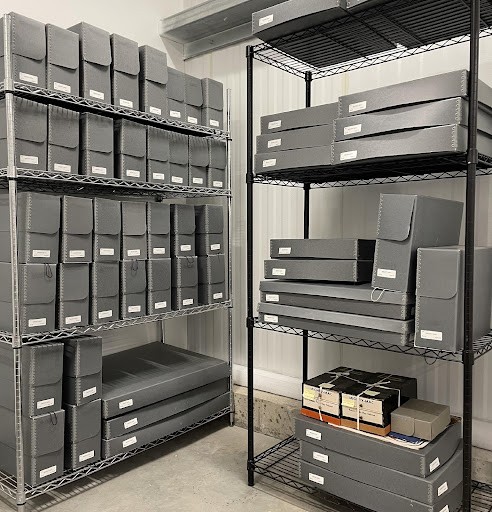The Origins of Mighty-Mac
Written by Howard Thomas in 2010.

Advertisement sketch. Mighty-Mac Collection of the Cape Ann Museum Library & Archives, Gloucester, MA. Gift of Richard Bell and Mac Bell, 2008 [Acc. #2008.29].

The Mighty-Mac Collection as it looks today in the Janet & William Ellery James Center at the CAM Green. The collection was processed by Howard Thomas in 2010.
In 1909 Morris Bell and Max Leavitt started a business to make oiled clothing for the Gloucester fishermen. Its famous “sou’wester” led to the production of other items such as work clothes, work gloves, heavy wool, and leather outerwear and even mattresses (the old excelsior stuffed cotton ticking kind) for fishing vessel bunks.

Cape Ann Manufacturing Co., c. 1930s.
Over time the original business, set up as the Gloucester Manufacturing Company with factories at 31 Commercial Street and 21 Main Street, evolved into the Cape Ann Manufacturing Company, which eventually evolved into the Mighty-Mac Company.
In the first World War the company made ponchos, lace breeches and shelter-tent halves (affectionately called pup-tents) in addition to the famous lines of oil cloths and rugged outerwear. In the late 1920s the company introduced its “collegiate slicker” and oilskin reached its peak demand. The depression marked the beginning of the demise of the oil clothing business but fortunately the company’s outerwear business remained strong. Style development and improved fit led to strong growth in the demand for outerwear garments and Mighty-Mac became the trademark for these products.

Advertisement mock-up for This is Boatwear. Right: Design sketch for coat, Challenger. Mighty-Mac Collection of the Cape Ann Museum Library & Archives, Gloucester, MA. Gift of Richard Bell and Mac Bell, 2008 [Acc. #2008.29].
From 1940 to 1945 the company was almost totally committed to the war program and made field jackets for the army, life jackets for the navy, and fragmentation bomb parachutes for the Army Ordinance. Research and development work on the Eisenhower jacket helped earn the coveted Army & Navy “E” award for excellence in production and quality for the company.

Workers at sewing machines at MIGHTY-MAC. Photograph by Barbara Erkkila, c. 1970s. Gift of Barbara Erkkila, 1999 [Acc. #1999.24].
After World War II the Mighty-Mac trademark and its supporting symbol, the Fisherman at the Wheel, became the mark of quality and good fashion throughout the clothing industry. Sales offices were opened in the Empire State Building in New York City and the Merchandise Mart in Chicago. Salesmen were added and marketing territories were expanded. Production facilities were expanded in 1953 by acquisition of a plant in Lawrence, MA., and in 1956 by building a new Gloucester plant at Emerson Ave, near the Annisquam River.

Left: Advertisement mock-up for Boatwear Out O’Gloucester. Right: Contact sheet of model showcasing a newly designed Mighty-Mac coat. Mighty-Mac Collection of the Cape Ann Museum Library & Archives, Gloucester, MA. Gift of Richard Bell and Mac Bell, 2008 [Acc. #2008.29].
Mighty-Mac remained a leader in style, quality and craftsmanship of its sport and spectator, summer and winter, men, women and children’s outerwear clothing for the next three decades. The company was sold to the Haddad Group, Ltd. of New York in 1985 BIOGRAPHIES Morris Bell and Molly Broder Bell were the parents of Richard S. Bell and Harold Bell. Morris Bell was the co-founder with Max Leavitt, in 1909, of the Gloucester Manufacturing Company. Morris Bell died in 1933. Richard S. Bell was born in 1912. He graduated in 1934 from Wharton School of Finance, University of Pennsylvania, and joined the family clothing company. He served as President and Director until the company was sold in 1985. Harold Bell was born in 1914. He attended the University of Maine at Orono for a year to study Forestry. He transferred to Yale University, New Haven, CN, and earned a degree in Economics in 1936. He began with the family clothing company on graduation and served as Treasurer and Director until the company was sold in 1985.

Clockwise: Sketch of coat, Boatman with accompanying notes; cloth swatches/samples; display of children’s coats in retail shop window. Mighty-Mac Collection of the Cape Ann Museum Library & Archives, Gloucester, MA. Gift of Richard Bell and Mac Bell, 2008 [Acc. #2008.29].
BIOGRAPHIES
Morris Bell and Molly Broder Bell were the parents of Richard S. Bell and Harold Bell. Morris Bell was the co-founder with Max Leavitt, in 1909, of the Gloucester Manufacturing Company. Morris Bell died in 1933.
Richard S. Bell was born in 1912. He graduated in 1934 from Wharton School of Finance, University of Pennsylvania, and joined the family clothing company. He served as President and Director until the company was sold in 1985.
Harold Bell was born in 1914. He attended the University of Maine at Orono for a year to study Forestry. He transferred to Yale University, New Haven, CN, and earned a degree in Economics in 1936. He began with the family clothing company on graduation and served as Treasurer and Director until the company was sold in 1985.
Bradley H. Bell was born on April 25, 1924, and died at age 69 years old on January 1, 1994. After graduating from Gloucester High School, Bradley earned a degree from Tilton Academy and Plymouth Teacher's College of Plymouth, NH. He was a manager at MIGHTY-MAC, having begun working at the family business in 1950, and continued to work with employees after the ownership change in 1985 by founding the temporary employment agency, Aid Inc. in Glocuester, MA.
Click here to read through the entire finding aid written by Howard in 2010.
And for more on Might-Mac, watch this 2008 Presentation at CAM on the “Women Workers at Mighty-Mac” with John Ronan and Gerolama Lovasco.
For a deeper look at Richard "Dick" Bell, click here for an article written by the Bell family for the Gloucester 400+ Stories Project.